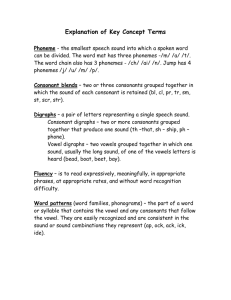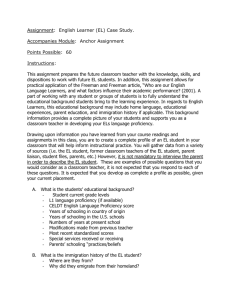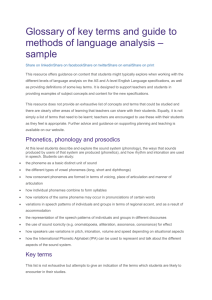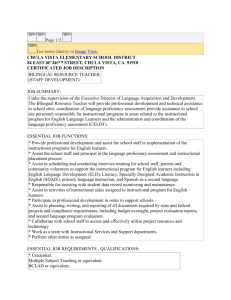Sound Systems: ppt
advertisement
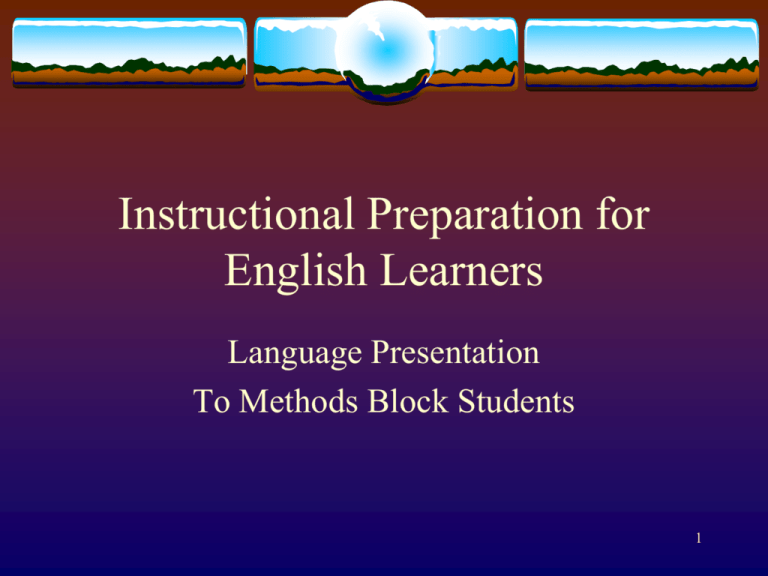
Instructional Preparation for English Learners Language Presentation To Methods Block Students 1 Why Aren’t English Learners Excelling? Linguistic Differences Cultural Differences & Biases Poverty and Associated Challenges Under Prepared Teachers 2 Spanish Vowel Phonemes /a/ paso (step) /e/ peso (weght) /i/ piso (floor) /o/ poso (sediment) /u/ puso (put) 3 English Vowel Phonemes 1. 2. 3. 4. 5. 6. 7. 8. /I/ /E/ /Ǽ/ /Ŋ/ /∧/ /Ư/ /ə/ /i:/ (pit) (pet) (pat) (pot) (luck) (good) (ago) (meat) 9. /a:/ 10. // 11. 14. /3:/ /u:/ /eI/ /aI/ 15. /I/ 16. /Ie/ 12. 13. (car) (door) (girl) (too) (day) (sky) (boy) (beer) 4 Special Note: Note that there are only 24 phonemes in the Spanish language There are five vowels and each only has one sound The remaining 19 consonant phonemes also have only one sound Spanish words beginning with “s” are always followed by a vowel Spanish speakers have special difficulty with words that begin with an “s” and followed by a consonant. Solo, Saber, Soltero, Salud, Soledad, Santa Barbara, etc. School, Stable, Stomach, Spring, Strolling, Scooter, etc. There are 44 phonemes in the English Language, 20 which are new sounds for Spanish-speaking students. 5 Spanish Consonant Phonemes (19) /p/ /t/ /k/ /b/ /d/ /g/ /T/ /s/ /tS/ paca (bale) cata (tasting) capa (cape) cava (sparkling wine) cada (each) toga (gown) caza (hunt) casa (house) cacha (gun butt) /x/ /m/ /n/ /ñ/ /l/ /l’l/ /R/ /r/ /f/ /Æ/ caja (box) cama (bed) cana (grey hair) caña (cane) cala (cove) calla (shut up) cara (face) carra (stage part forro (lining) callo (corn on foot 6 English Consonant Phonemes (21) /p/ /b/ /T/ /d/ /k/ /g/ /f/ /Ø/ /ð/ /s/ pit bit time door cat get fan think that send /z/ /m/ /n/ /ŋ/ /l/ /r/ /w/ /h/ /ĵ/ /§/ /tƒ/ zip man nice ring leg rat wet hat yet shop chop 7 Special Note The sound of “schwa”, usually pronounced “uh” is the most common vowel sound in English: (..but note that at times, that “sound” corresponds to every other vowel and not just “u”) Again, Birth, Bakery, Action, Under, Ancient, Person, Television, Lesson, etc. This is extremely confusing for English Language Learners. 8 “Reading First” is a Strong Component of NCLB “Every kindergarten through third grade reading program must contain explicit and systematic instruction in the following five areas: Phonemic awareness Phonics Vocabulary development Reading Fluency (inc. oral reading skills Reading comprehension strategies 9 Phonemes & Phonics Cautions One way of simplifying the problem is to look for commonalities & studying the differences: English letters, b,c,d,f,l,m,n,p q,s and t represent sounds that are similar enough to English that they may transfer readily to English reading. Because English vowels have numerous spellings, ELL students used to 1 to 1 Spanish correspondence need to have the differences pointed out. Some of the English phonemes are not present in ELLs’ native language and, therefore, may be difficult for a student to pronounce and distinguish auditorily, as well as to decipher any meaning from what he/she hears. Oral training in the “new sounds” is important. 10 English Phonetics Are Unique Please Read This Yue mae wundir hau a purcin cood reed funetikly vairey fluently. Sumtaimz it bukumz daunwryt straenje. (…but don’t try spelling this way in school!) 11 Phonetics Is Not The Only Problem Lexicon: The vocabulary of terms as used in a particular branch of knowledge. Although a student may appear to speak English for conversational purposes, “schooling” requires ever more complicated uses of new and uncommon words that must be taught throughout content instruction. (BICS & CALPS) Pragmatics: The branch of linguistic study that deals with how language is used, especially the factors that influence people's choice of words. Proper use of language in different settings is key to acceptable behavior. Student must learn to use language in practical settings. Instructional Conversations provides 12 the opportunity. Some Truisms About Instruction Teach words that students are likely to see and use again. Teach words that are important to understanding a concept or the text. Learning in rich contexts is valuable for vocabulary development. Teaching specific words before reading helps both, vocabulary acquisition and comprehension 13 California English Language Development Test (CELDT) ADVANCED: Students performing at this level of English language proficiency communicate effectively with various audiences on a wide range of familiar and new topics to meet social and academic demands. In order to attain the English proficiency level of their native English-speaking peers, further linguistic enhancement and refinement are necessary. EARLY ADVANCED: Students performing at this level of English language proficiency begin to combine the elements of the English language in complex, cognitively demanding situations and are able to use English as a means for learning in other academic areas. 14 CELDT, cont. INTERMEDIATE: Students performing at this level of English language proficiency begin to tailor the English language skills they have been taught to meet their immediate communication and learning needs. EARLY INTERMEDIATE: Students performing at this level of English language proficiency start to respond with increasing ease to more varied communication tasks. BEGINNING: Students performing at this level of English language proficiency may demonstrate little or no receptive or productive English skills. They may be able to respond to some communication tasks. 15 CELDT English Language Assessment Categories K – 2 Listening & Speaking 2nd Word Analysis, Fluency & Vocabulary Development, Reading Comprehension, Writing Conventions, Strategies and Applications 3rd – 5th Listening, Speaking, Word Analysis, Fluency and Vocabulary Development, Reading Comprehension and Literary Analysis, Writing Conventions, Strategies and Applications 16 Ventura CELDT – 2003-2004 Grades K 1 2 3 Overall Proficiency 4 6 7 8 9 10 11 12 Total Tested Number and Percent of Students at Each Overall Proficiency Level Annual Assessment - All Students Advanced Early Advanced 5 7 5.0% 226 7.0% 179 5.0% 117 4.0% 286 10.0% 494 18.0% 133 6.0% 214 10.0% 312 17.0% 95 11.0% 218 17.0% 297 25.0% 219 25.0% 2,797 11.0% 32 25.0% 697 21.0% 425 13.0% 429 13.0% 768 26.0% 993 36.0% 713 32.0% 811 40.0% 744 41.0% 377 42.0% 481 39.0% 447 38.0% 335 39.0% 7,252 28.0% 38 30.0% 1,221 37.0% 1,126 34.0% 1,008 32.0% 1,105 37.0% 879 32.0% 947 42.0% 737 36.0% 494 27.0% 256 29.0% 328 26.0% 294 25.0% 219 25.0% 8,652 33.0% 24 19.0% 686 21.0% 979 30.0% 925 29.0% 560 19.0% 262 9.0% 315 14.0% 180 9.0% 137 8.0% 96 11.0% 138 11.0% 103 9.0% 77 9.0% 4,482 17.0% 27 21.0% 455 14.0% 580 18.0% 717 22.0% 281 9.0% 150 5.0% 147 7.0% 110 5.0% 135 7.0% 68 8.0% 84 7.0% 41 3.0% 17 2.0% 2,812 11.0% 128 100.0 % 3,285 100.0 % 3,289 100.0 % 3,196 100.0 % 3,000 100.0 % 2,778 100.0 % 2,255 100.0 % 2,052 100.0 % 1,822 100.0 % 892 100.0 % 1,249 100.0 % 1,182 100.0 % 867 100.0 % Intermediate Early Intermediate Beginning Number Tested 17 25,995 Catching Up… Actually, there is no catching up unless the dominant English speakers stand still for a while and let the second-language learners continue learning until they catch up. Teachers who are aware of the vast difference between second language learners and native speakers need to continually develop English Learners Proficiency in English. Instructional Conversations provides such an setting. 18 Instructional Conversations Instructional Conversation is "talk in which ideas are explored rather than answers to teachers' test questions provided and evaluated.“ Five critical features include: It is interesting and engaging. It is about an idea or a concept that has meaning and relevance for students. It has a focus that, while it may shift as the discussion evolves, remains discernible throughout. There is a high level of participation, without undue domination by any one individual, particularly the teacher. Student engage in extended discussions -- conversations -with the teacher and among themselves. 19 Because The Teacher Is Aware of Continual Language Development... 1. 2. 3. 4. 5. 6. 7. 8. Arranges the classroom to accommodate conversation between the teacher and a small group of students on a regular and frequent basis. Has a clear academic goal that guides conversation with students. Ensures that student talk occurs at higher rates than teacher talk. Guides conversation to include students' views, judgments, and rationales using text evidence and other substantive support. Ensures that all students are included in the conversation according to their preferences. Listens carefully to assess levels of students' understanding. Assists students’ learning throughout the conversation by questioning, restating, praising, encouraging, etc. Guides the students to prepare a product that indicates the20 Instructional Conversation's goal was achieved.


